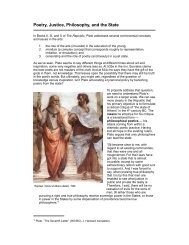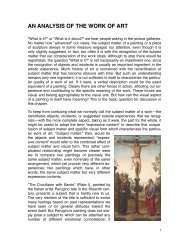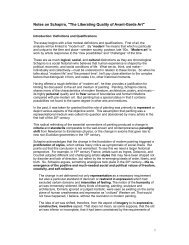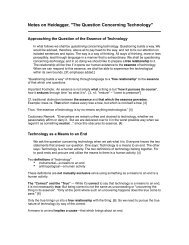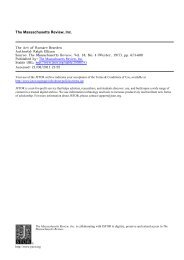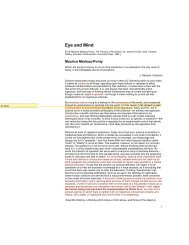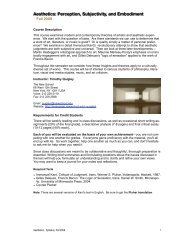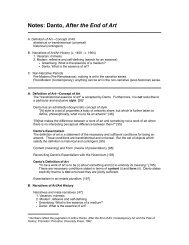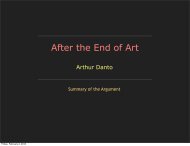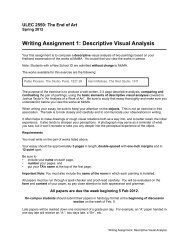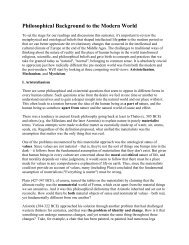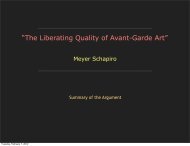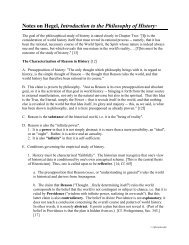THE VISIBLE AND THE INVISIBLE: - Timothy R. Quigley
THE VISIBLE AND THE INVISIBLE: - Timothy R. Quigley
THE VISIBLE AND THE INVISIBLE: - Timothy R. Quigley
Create successful ePaper yourself
Turn your PDF publications into a flip-book with our unique Google optimized e-Paper software.
247<br />
<strong>THE</strong> <strong>VISIBLE</strong> <strong>AND</strong> <strong>THE</strong> IN<strong>VISIBLE</strong>:<br />
<strong>THE</strong> INTERTWINING - <strong>THE</strong> CHIASM<br />
Maurice Merleau-Ponty<br />
Originally from The Visible and the Invisible, pp. 130-55 in the 1968 translation. This<br />
version from Maurice Merleau-Ponty: basic writings, ed. Thomas Baldwin, Routledge<br />
(2004).<br />
Introduction by Thomas Baldwin<br />
This chapter comes from a manuscript which was incomplete at MerleauPonty's death. In<br />
1959 he converted his long-standing ambition to write a book about truth (see p. 34) into<br />
the project of a book about `the visible and the invisible; in which he would move from a<br />
discussion of perception ('the visible’) to one of language and thence truth (‘the invisible’).<br />
The manuscript really addresses only the first part of this (though there are notes for the<br />
later parts); so it primarily represents his later thoughts about perception. In the first<br />
chapter Merleau-Ponty returns to his critique of realism and intellectualism. He then<br />
provides, in the second chapter, a decisive refutation of Sartre's Hegelian account in Being<br />
and Nothingness of our being in the world (see p. 29). In the third chapter he discusses<br />
critically Bergson's conception of 'intuition' and then begins to set out his own thoughts<br />
about temporality and language. But it is in the fourth chapter, reproduced here, that he<br />
breaks new ground.<br />
The title of the chapter indicates his new conception of the body, as a 'chiasm' or<br />
crossing-over (the term comes from the Greek letter chi) which combines subjective experience<br />
and objective existence. His term for this new conception of the body is 'flesh' (chair) and he<br />
insists that it is an 'ultimate notion; a 'concrete emblem of a general manner of being; which<br />
provides access both to subjective experience and objective existence. The phenomenon he<br />
concentrates upon is one he had discussed earlier in The Phenomenology of<br />
Perception (PP 92 [106]J, that of touching one hand<br />
248<br />
with the other hand. This phenomenon, he suggests, reveals to us the two dimensions of our<br />
‘flesh’, that it is both a form of experience (tactile experience) and something that can be<br />
touched. It is both 'touching' and ‘tangible’: Furthermore the relationship is reversible: the<br />
hand that touches can be felt as touched, and vice versa, though never both at the same time,<br />
and it is this 'reversibility' that he picks out as the essence of flesh. It shows us the<br />
ambiguous status of our bodies as both subject and object. Thus Merleau-Ponty here<br />
qualifies his earlier view that gave priority to the 'phenomenal; subjective, body over the<br />
objective body. For he now regards these as but two aspects of a single fundamental<br />
phenomenon: our reversible flesh' (the influence of Husserl is perhaps apparent here: in<br />
Ideas II he had affirmed that 'the Body as Body presents, like Janus, two faces’, p. 297,<br />
though the 'faces' in question are not Merleau-Ponty's alternatives).<br />
Merleau-Ponty extends the application of this conception in two directions. First, he<br />
extends it from touch to sight, which he now models on touch -'the look we said, envelops,<br />
palpates, espouses visible things: So sight has the same ambiguous nature as touch, and it is<br />
from its own 'objective' side that the objectivity of the visible world is generated. Second,<br />
taking the example of a handshake as exemplary, he extends his thesis to apply to our<br />
sense that others, like us, are both subjects and objects. Although these points are clear<br />
enough, and the chapter is not, as it stands, incomplete, it remains unclear how he intended<br />
to extend the line of thought further, since the manuscript ends at this point, and the notes<br />
that follow do not provide a connected discussion. Thus at this point there is a genuine sense<br />
of a thinker stopped in midair, and it is just not clear where the trajectory of his thought<br />
would have carried him. -- TB<br />
<strong>THE</strong> INTERTWINING - <strong>THE</strong> CHIASM<br />
If it is true that as soon as philosophy declares itself to be reflection or coincidence it<br />
prejudges what it will find, then once again it must recommence everything, reject the<br />
instruments reflection and intuition had provided themselves, and install itself in a<br />
locus where they have not yet been distinguished, in experiences that have not yet<br />
been "worked over," that offer us all at once, pell-mell, both "subject" and "object,"<br />
both existence and essence, and hence give philosophy resources to redefine them.<br />
Seeing, speaking, even thinking (with certain reservations, for as soon as we<br />
distinguish thought from speaking absolutely we are already in the order of<br />
reflection), are experiences of this kind, both irrecusable and enigmatic. They have a<br />
name in all languages, but a name which in all of them also conveys significations in<br />
tufts, thickets of proper meanings and figurative meanings, so that,
249<br />
unlike those of science, not one of these names clarifies by attributing to what is<br />
named a circumscribed signification. Rather, they are the repeated index, the insistent<br />
reminder of a mystery as familiar as it is unexplained, of a light which, illuminating<br />
the rest, remains at its source in obscurity. If we could rediscover within the exercise<br />
of seeing and speaking some of the living references that assign them such a destiny<br />
in a language, perhaps they would teach us how to form our new instruments, and<br />
first of all to understand our research, our interrogation, themselves.<br />
The visible about us seems to rest in itself. It is as though our vision were<br />
formed in the heart of the visible, or as though there were between it and us an<br />
intimacy as close as between the sea and the strand. And yet it is not possible that we<br />
blend into it, nor that it passes into us, for then the vision would vanish at the<br />
moment of formation, by disappearance of the seer or of the visible. What there is<br />
then are not things first identical with themselves, which would then offer themselves<br />
to the seer, nor is there a seer who is first empty and who, afterward, would open<br />
himself to them - but something to which we could not be closer than by palpating it<br />
with our look, things we could not dream of seeing “ all naked” because the gaze itself<br />
envelops them, clothes them with its own flesh. Whence does it happen that in so<br />
doing it leaves them in their place, that the vision we acquire of them seems to us to<br />
come from them, and that to be seen is for them but a degradation of their eminent<br />
being? What is this talisman of color, this singular virtue of the visible that makes it,<br />
held at the end of the gaze, nonetheless much more than a correlative of my vision,<br />
such that it imposes my vision upon me as a continuation of its own sovereign<br />
existence? How does it happen that my look, enveloping them, does not hide them,<br />
and, finally, that, veiling them, it unveils them?[1]<br />
We must first understand that this red under my eyes is not, as is always said, a<br />
quale, a pellicle of being without thickness, a message at the same time indecipherable<br />
and evident, which one has or has not received, but of which, if one has received it,<br />
one knows all there is to know, and of which in the end there is nothing to say. It<br />
requires a focusing, however brief; it emerges from a less precise, more general<br />
redness, in which my gaze was caught, into which it sank, before - as we put it so<br />
aptly - fixing it. And, now that I have fixed it, if my eyes penetrate into it, into its fixed<br />
structure, or if they start to wander round about again, the quale resumes its<br />
atmospheric existence. Its precise<br />
250<br />
form is bound up with a certain wooly, metallic, or porous [?] configuration or<br />
texture, and the quale itself counts for very little compared with these participations.<br />
Claudel has a phrase saying that a certain blue of the sea is so blue that only blood<br />
would be more red. The color is yet a variant in another dimension of variation, that<br />
of its relations with the surroundings: this red is what it is only by connecting up<br />
from its place with other reds about it, with which it forms a constellation, or with<br />
other colors it dominates or that dominate it, that it attracts or that attract it, that it<br />
repels or that repel it. In short, it is a certain node in the woof of the simultaneous<br />
and the successive. It is a concretion of visibility, it is not an atom. The red dress a<br />
fortiori holds with all its fibers onto the fabric of the visible, and thereby onto a<br />
fabric of invisible being. A punctuation in the field of red things, which includes the<br />
tiles of roof tops, the flags of gatekeepers and of the Revolution, certain terrains near<br />
Aix or in Madagascar, it is also a punctuation in the field of red garments, which<br />
includes, along with the dresses of women, robes of professors, bishops, and<br />
advocate generals, and also in the field of adornments and that of uniforms. And its<br />
red literally is not the same as it appears in one constellation or in the other, as the<br />
pure essence of the Revolution of 1917 precipitates in it, or that of the eternal<br />
feminine, or that of the public prosecutor, or that of the gypsies dressed like hussars<br />
who reigned twenty-five years ago over an inn on the Champs-Elysées. A certain red<br />
is also a fossil drawn up from the depths of imaginary worlds. If we took all these<br />
participations into account, we would recognize that a naked color, and in general a<br />
visible, is not a chunk of absolutely hard, indivisible being, offered all naked to a<br />
vision which could be only total or null, but is rather a sort of straits between exterior<br />
horizons and interior horizons ever gaping open, something that comes to touch<br />
lightly and makes diverse regions of the colored or visible world resound at the<br />
distances, a certain differentiation, an ephemeral modulation of this world - less a<br />
color or a thing, therefore, than a difference between things and colors, a momentary<br />
crystallization of colored being or of visibility. Between the alleged colors and<br />
visibles, we would find anew the tissue that lines them, sustains them, nourishes<br />
them, and which for its part is not a thing, but a possibility, a latency, and a flesh of<br />
things.<br />
If we turn now to the seer, we will find that this is no analogy or vague<br />
comparison and must be taken literally. The look, we said, envelops, palpates,<br />
espouses the visible things. As though it were in a relation of pre-established<br />
harmony with them, as though it knew them before knowing them, it moves in its<br />
own way with its abrupt and imperious
251<br />
style, and yet the views taken are not desultory - I do not look at a chaos, but at<br />
things - so that finally one cannot say if it is the look or if it is the things that<br />
command. What is this prepossession of the visible, this art of interrogating it<br />
according to its own wishes, this inspired exegesis? We would perhaps find the<br />
answer in the tactile palpation where the questioner and the questioned are closer,<br />
and of which, after all, the palpation of the eye is a remarkable variant. How does it<br />
happen that I give to my hands, in particular, that degree, that rate, and that direction<br />
of movement that are capable of making me feel the textures of the sleek and the<br />
rough? Between the exploration and what it will teach me, between my movements<br />
and what I touch, there must exist some relationship by principle, some kinship,<br />
according to which they are not only, like the pseudopods of the amoeba, vague and<br />
ephemeral deformations of the corporeal space, but the initiation to and the opening<br />
upon a tactile world. This can happen only if my hand, while it is felt from within, is<br />
also accessible from without, itself tangible, for my other hand, for example, if it<br />
takes its place among the things it touches, is in a sense one of them, opens finally<br />
upon a tangible being of which it is also a part. Through this crisscrossing within it of<br />
the touching and the tangible, its own movements incorporate themselves into the<br />
universe they interrogate, are recorded on the same map as it; the two systems are<br />
applied upon one another, as the two halves of an orange. It is no different for the<br />
vision - except, it is said, that here the exploration and the information it gathers do<br />
not belong "to the same sense." But this delimitation of the senses is crude. Already<br />
in the "touch" we have just found three distinct experiences which subtend one<br />
another, three dimensions which overlap but are distinct: a touching of the sleek and<br />
of the rough, a touching of the things - a passive sentiment of the body and of its<br />
space - and finally a veritable touching of the touch, when my right hand touches my<br />
left hand while it is palpating the things, where the "touching subject" passes over to<br />
the rank of the touched, descends into the things, such that the touch is formed in<br />
the midst of the world and as it were in the things. Between the massive sentiment I<br />
have of the sack in which I am enclosed, and the control from without that my hand<br />
exercises over my hand, there is as much difference as between the movements of<br />
my eyes and the changes they produce in the visible. And as, conversely, every<br />
experience of the visible has always been given to me within the context of the<br />
movements of the look, the visible spectacle belongs to the touch neither more nor<br />
less than do the "tactile qualities." We must habituate ourselves to think that every<br />
visible is cut out in the tangible, every tactile<br />
252<br />
being in some manner promised to visibility, and that there is encroachment,<br />
infringement, not only between the touched and the touching, but also between the<br />
tangible and the visible, which is encrusted in it, as, conversely, the tangible itself is<br />
not a nothingness of visibility, is not without visual existence. Since the same body<br />
sees and touches, visible and tangible belong to the same world. It is a marvel too<br />
little noticed that every movement of my eyes - even more, every displacement of my<br />
body - has its place in the same visible universe that I itemize and explore with them,<br />
as, conversely, every vision takes place somewhere in the tactile space. There is<br />
double and crossed situating of the visible in the tangible and of the tangible in the<br />
visible; the two maps are complete, and yet they do not merge into one. The two<br />
parts are total parts and yet are not superposable.<br />
Hence, without even entering into the implications proper to the seer and the<br />
visible, we know that, since vision is a palpation with the look, it must also be<br />
inscribed in the order of being that it discloses to us; he who looks must not himself<br />
be foreign to the world that he looks at. As soon as I see, it is necessary that the<br />
vision (as is so well indicated by the double meaning of the word) be doubled with a<br />
complementary vision or with another vision: myself seen from without, such as<br />
another would see me, installed in the midst of the visible, occupied in considering it<br />
from a certain spot. For the moment we shall not examine how far this identity of<br />
the seer and the visible goes, if we have a complete experience of it, or if there is<br />
something missing, and what it is. It suffices for us for the moment to note that he<br />
who sees cannot possess the visible unless he is possessed by it, unless he is of it,[2]<br />
unless, by principle, according to what is required by the articulation of the look with<br />
the things, he is one of the visibles, capable, by a singular reversal, of seeing them -<br />
he who is one of them.[3]<br />
We understand then why we see the things themselves, in their places, where<br />
they are, according to their being which is indeed more than their being-perceived -<br />
and why at the same time we are separated from them by all the thickness of the look<br />
and of the body; it is that this distance is not the contrary of this proximity, it is<br />
deeply consonant with it, it is synonymous with it. It is that the thickness of flesh<br />
between the seer and the thing is constitutive for the thing of its visibility as for the<br />
seer of his corporeity; it is not an obstacle between them, it is their means of<br />
communication. It is for the same reason that I am at the heart of the visible and that<br />
I am far from it: because it has thickness and is thereby naturally destined to be seen<br />
by a body. What is indefinable in the quale, in the color, is nothing else than
253<br />
a brief, peremptory manner of giving in one sole something, in one sole tone of<br />
being, visions past, visions to come, by whole clusters. I who see have my own depth<br />
also, being backed up by this same visible which I see and which, I know very well,<br />
closes in behind me. The thickness of the body, far from rivaling that of the world, is<br />
on the contrary the sole means I have to go unto the heart of the things, by making<br />
myself a world and by making them flesh.<br />
The body interposed is not itself a thing, an interstitial matter, a connective<br />
tissue, but a sensible for itself, which means, not that absurdity: color that sees itself,<br />
surface that touches itself - but this paradox [?]: a set of colors and surfaces inhabited<br />
by a touch, a vision, hence an exemplar sensible, which offers to him who inhabits it<br />
and senses it the wherewithal to sense everything that resembles himself on the<br />
outside, such that, caught up in the tissue of the things, it draws it entirely to itself,<br />
incorporates it, and, with the same movement, communicates to the things upon<br />
which it closes over that identity without superposition, that difference without<br />
contradiction, that divergence between the within and the without that constitutes its<br />
natal secret.[4] The body unites us directly with the things through its own<br />
ontogenesis, by welding to one another the two outlines of which it is made, its two<br />
laps: the sensible mass it is and the mass of the sensible wherein it is born by<br />
segregation and upon which, as seer, it remains open. It is the body and it alone,<br />
because it is a two-dimensional being, that can bring us to the things themselves,<br />
which are themselves not flat beings but beings in depth, inaccessible to a subject<br />
that would survey them from above, open to him alone that, if it be possible, would<br />
coexist with them in the same world. When we speak of the flesh of the visible, we<br />
do not mean to do anthropology, to describe a world covered over with all our own<br />
projections, leaving aside what it can be under the human mask. Rather, we mean<br />
that carnal being, as a being of depths, of several leaves or several faces, a being in<br />
latency, and a presentation of a certain absence, is a prototype of Being, of which our<br />
body, the sensible sentient, is a very remarkable variant, but whose constitutive<br />
paradox already lies in every visible. For already the cube assembles within itself<br />
incompossible visibilia, as my body is at once phenomenal body and objective body,<br />
and if finally it is, it, like my body, is by a tour de force. What we call a visible is, we<br />
said, a quality pregnant with a texture, the surface of a depth, a cross section upon a<br />
massive being, a grain or corpuscle borne by a wave of Being. Since the total visible is<br />
always behind, or after, or between the aspects we see of it, there is access to it only<br />
through an experience which, like it, is wholly outside of itself. It is thus, and not as<br />
the bearer of a knowing subject, that our body commands the visible for us,<br />
254<br />
but it does not explain it, does not clarify it, it only concentrates the mystery of its<br />
scattered visibility; and it is indeed a paradox of Being, not a paradox of man, that we<br />
are dealing with here. To be sure, one can reply that, between the two "sides" of our<br />
body, the body as sensible and the body as sentient (what in the past we called<br />
objective body and phenomenal body), rather than a spread, there is the abyss that<br />
separates the In Itself from the For Itself. It is a problem - and we will not avoid it -<br />
to determine how the sensible sentient can also be thought. But here, seeking to form<br />
our first concepts in such a way as to avoid the classical impasses, we do not have to<br />
honor the difficulties that they may present when confronted with a cogito, which<br />
itself has to be re-examined. Yes or no: do we have a body - that is, not a permanent<br />
object of thought, but a flesh that suffers when it is wounded, hands that touch? We<br />
know: hands do not suffice for touch - but to decide for this reason alone that our<br />
hands do not touch, and to relegate them to the world of objects or of instruments,<br />
would be, in acquiescing to the bifurcation of subject and object, to forego in<br />
advance the understanding of the sensible and to deprive ourselves of its lights. We<br />
propose on the contrary to take it literally to begin with. We say therefore that our<br />
body is a being of two leaves, from one side a thing among things and otherwise<br />
what sees them and touches them; we say, because it is evident, that it unites these<br />
two properties within itself, and its double belongingness to the order of the "object"<br />
and to the order of the "subject" reveals to us quite unexpected relations between the<br />
two orders. It cannot be by incomprehensible accident that the body has this double<br />
reference; it teaches us that each calls for the other. For if the body is a thing among<br />
things, it is so in a stronger and deeper sense than they: in the sense that, we said, it is<br />
of them, and this means that it detaches itself upon them, and, accordingly, detaches<br />
itself from them. It is not simply a thing seen in fact (I do not see my back), it is<br />
visible by right, it falls under a vision that is both ineluctable and deferred.<br />
Conversely, if it touches and sees, this is not because it would have the visibles before<br />
itself as objects: they are about it, they even enter into its enclosure, they are within it,<br />
they line its looks and its hands inside and outside. If it touches them and sees them,<br />
this is only because, being of their family, itself visible and tangible, it uses its own<br />
being as a means to participate in theirs, because each of the two beings is an<br />
archetype for the other, because the body belongs to the order of the things as the<br />
world is universal flesh. One should not even say, as we did a moment ago, that the<br />
body is made up of two leaves, of which the one, that of the "sensible," is bound up<br />
with the rest of the world.
255<br />
There are not in it two leaves or two layers; fundamentally it is neither thing seen<br />
only nor seer only, it is Visibility sometimes wandering and sometimes reassembled.<br />
And as such it is not in the world, it does not detain its view of the world as within a<br />
private garden: it sees the world itself, the world of everybody, and without having to<br />
leave "itself," because it is wholly - because its hands, its eyes, are nothing else than -<br />
this reference of a visible, a tangible-standard to all those whose resemblance it bears<br />
and whose evidence it gathers, by a magic that is the vision, the touch themselves. To<br />
speak of leaves or of layers is still to flatten and to juxtapose, under the reflective<br />
gaze, what coexists in the living and upright body. If one wants metaphors, it would<br />
be better to say that the body sensed and the body sentient are as the obverse and the<br />
reverse, or again, as two segments of one sole circular course which goes above from<br />
left to right and below from right to left, but which is but one sole movement in its<br />
two phases. And everything said about the sensed body pertains to the whole of the<br />
sensible of which it is a part, and to the world. If the body is one sole body in its two<br />
phases, it incorporates into itself the whole of the sensible and with the same<br />
movement incorporates itself into a "Sensible in itself" We have to reject the age-old<br />
assumptions that put the body in the world and the seer in the body, or, conversely,<br />
the world and the body in the seer as in a box. Where are we to put the limit between<br />
the body and the world, since the world is flesh? Where in the body are we to put the<br />
seer, since evidently there is in the body only "shadows stuffed with organs," that is,<br />
more of the visible? The world seen is not "in" my body, and my body is not "in" the<br />
visible world ultimately: as flesh applied to a flesh, the world neither surrounds it nor<br />
is surrounded by it. A participation in and kinship with the visible, the vision neither<br />
envelops it nor is enveloped by it definitively. The superficial pellicle of the visible is<br />
only for my vision and for my body. But the depth beneath this surface contains my<br />
body and hence contains my vision. My body as a visible thing is contained within<br />
the full spectacle. But my seeing body subtends this visible body, and all the visibles<br />
with it. There is reciprocal insertion and intertwining of one in the other. Or rather,<br />
if, as once again we must, we eschew the thinking by planes and perspectives, there<br />
are two circles, or two vortexes, or two spheres, concentric when I live naively, and<br />
as soon as I question myself, the one slightly decentered with respect to the other....<br />
We have to ask ourselves what exactly we have found with this strange adhesion<br />
of the seer and the visible. There is vision, touch, when a certain visible, a certain<br />
tangible, turns back upon the whole of the visible, the whole<br />
256<br />
of the tangible, of which it is a part, or when suddenly it finds itself surrounded by<br />
them, or when between it and them, and through their commerce, is formed a<br />
Visibility, a Tangible in itself, which belong properly neither to the body qua fact nor<br />
to the world qua fact - as upon two mirrors facing one another where two indefinite<br />
series of images set in one another arise which belong really to neither of the two<br />
surfaces, since each is only the rejoinder of the other, and which therefore form a<br />
couple, a couple more real than either of them. Thus since the seer is caught up in<br />
what he sees, it is still himself he sees: there is a fundamental narcissism of all vision.<br />
And thus, for the same reason, the vision he exercises, he also undergoes from the<br />
things, such that, as many painters have said, I feel myself looked at by the things, my<br />
activity is equally passivity - which is the second and more profound sense of the<br />
narcissim: not to see in the outside, as the others see it, the contour of a body one<br />
inhabits, but especially to be seen by the outside, to exist within it, to emigrate into it,<br />
to be seduced, captivated, alienated by the phantom, so that the seer and the visible<br />
reciprocate one another and we no longer know which sees and which is seen. It is<br />
this Visibility, this generality of the Sensible in itself, this anonymity innate to Myself<br />
that we have previously called flesh, and one knows there is no name in traditional<br />
philosophy to designate it. The flesh is not matter, in the sense of corpuscles of being<br />
which would add up or continue on one another to form beings. Nor is the visible<br />
(the things as well as my own body) some "psychic" material that would be - God<br />
knows how - brought into being by the things factually existing and acting on my<br />
factual body. In general, it is not a fact or a sum of facts "material" or "spiritual." Nor<br />
is it a representation for a mind: a mind could not be captured by its own<br />
representations; it would rebel against this insertion into the visible which is essential<br />
to the seer. The flesh is not matter, is not mind, is not substance. To designate it, we<br />
should need the old term "element," in the sense it was used to speak of water, air,<br />
earth, and fire, that is, in the sense of a general thing, midway between the spatiotemporal<br />
individual and the idea, a sort of incarnate principle that brings a style of<br />
being wherever there is a fragment of being. The flesh is in this sense an "element" of<br />
Being. Not a fact or a sum of facts, and yet adherent to location and to the now. Much<br />
more: the inauguration of the where and the when, the possibility and exigency for the<br />
fact; in a word: facticity, what makes the fact be a fact. And, at the same time, what<br />
makes the facts have meaning, makes the fragmentary facts dispose themselves about<br />
"something." For if there is flesh, that is, if the hidden face of the cube radiates forth<br />
somewhere as well
257<br />
as does the face I have under my eyes, and coexists with it, and if I who see the cube<br />
also belong to the visible, I am visible from elsewhere, and if I and the cube are<br />
together caught up in one same "element" (should we say of the seer, or of the<br />
visible?), this cohesion, this visibility by principle, prevails over every momentary<br />
discordance. In advance every vision or very partial visible that would here<br />
definitively come to naught is not nullified (which would leave a gap in its place), but,<br />
what is better, it is replaced by a more exact vision and a more exact visible,<br />
according to the principle of visibility, which, as though through a sort of abhorrence<br />
of a vacuum, already invokes the true vision and the true visible, not only as<br />
substitutes for their errors, but also as their explanation, their relative justification, so<br />
that they are, as Husserl says so aptly, not erased, but "crossed out."… Such are the<br />
extravagant consequences to which we are led when we take seriously, when we<br />
question, vision. And it is, to be sure, possible to refrain from doing so and to move<br />
on, but we would simply find again, confused, indistinct, non-clarified, scraps of this<br />
ontology of the visible mixed up with all our theories of knowledge, and in particular<br />
with those that serve, desultorily, as vehicles of science. We are, to be sure, not<br />
finished ruminating over them. Our concern in this preliminary outline was only to<br />
catch sight of this strange domain to which interrogation, properly so-called, gives<br />
access....



